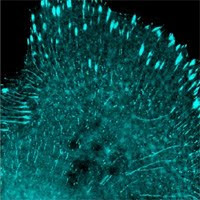Since its discovery pluripotent stem cells (iPSCs) have been known to differ somewhat from embryonic stem cells (ESCs) in term of gene expression profiles. It also appears that only a small percentage of iPSCs have the full potential of stem cells defined by being able to develop into adult animals. Instead of a global pattern of variations, surprisingly, the difference between iPSC and ESC was found to localize in a small region of one chromosome in mouse, 12qF1, which could account for most iPS cells’ lack of complete pluripotency (Stadtfeld et al, Nature 2010). In this region resides an imprinted gene cluster that includes 2 non-coding genes, Gtl2 and Rian, that remain silenced in most iPSCs. The underlining mechanism is hypermethylation and hypoacetylation, resulting in “paternalizaition” of the region. The effects are manifested around the mid-gestation stage.
By adding histone deacetylase inhibitor valproic acid (VPA) the silenced gene cluster may be reactivated and the iPSCs so treated show increased Gtl2 expression and ability to give rise to normal embryos. Expression of other imprinted genes showed clone-to-clone variations, as was previously reported by a number of groups, but no consistent differences between ESCs cells and iPSCs. Therefore, by analyzing the expression levels of just two genes, Gtl2 and Rian, the potential of iPSCs to be fully pluripotent can be assessed.
The relationships between stem cell status and epigenetic repressions also include the recent finding that Oct4 and Sox2, which are both germ cell-specific and critical reprogramming factors, may be implicated in the regulation of Xist and Tsix RNAs that control epigenetic silencing of X chromosome in female embryos.
New Product of the Week 05-17-10 to 05-23-10: RT-PCR primer set, ABP-SC-iPSh4NX $49, for identifying exogenous iPS factor expression from 4-in-1 iPS lentivirus
Promotion of the Week 05-17-10 to 05-23-10: $85 off IceCube dry bath 0-75C variable temp




No comments:
Post a Comment